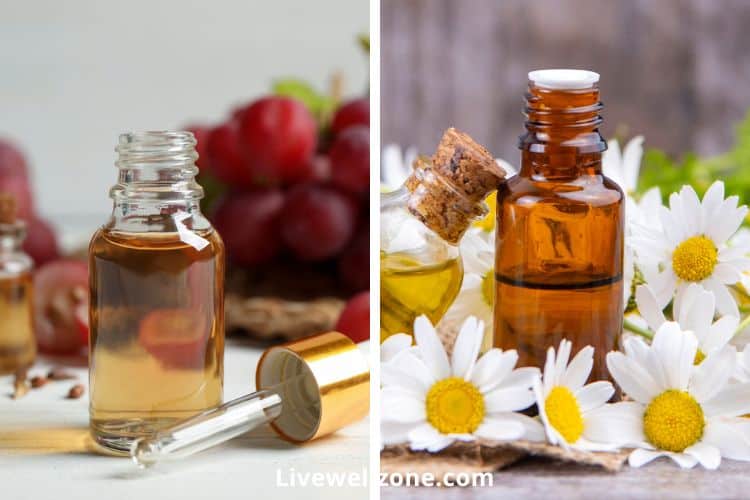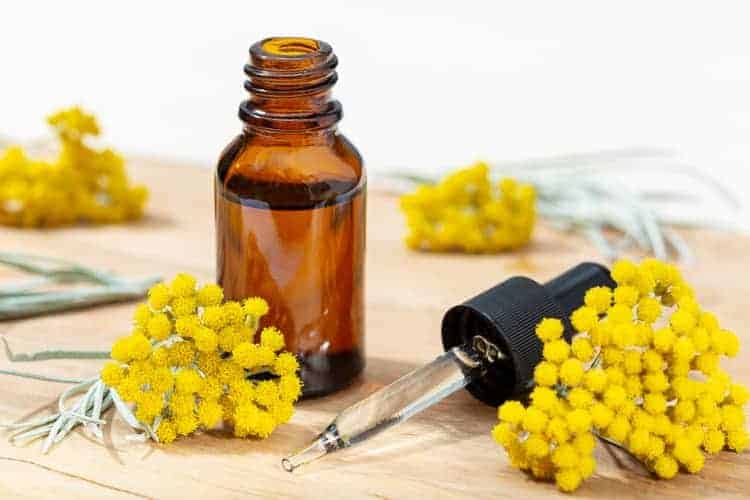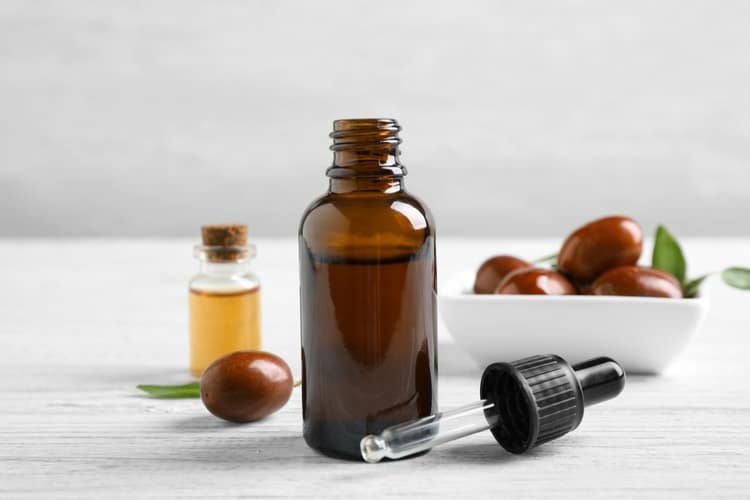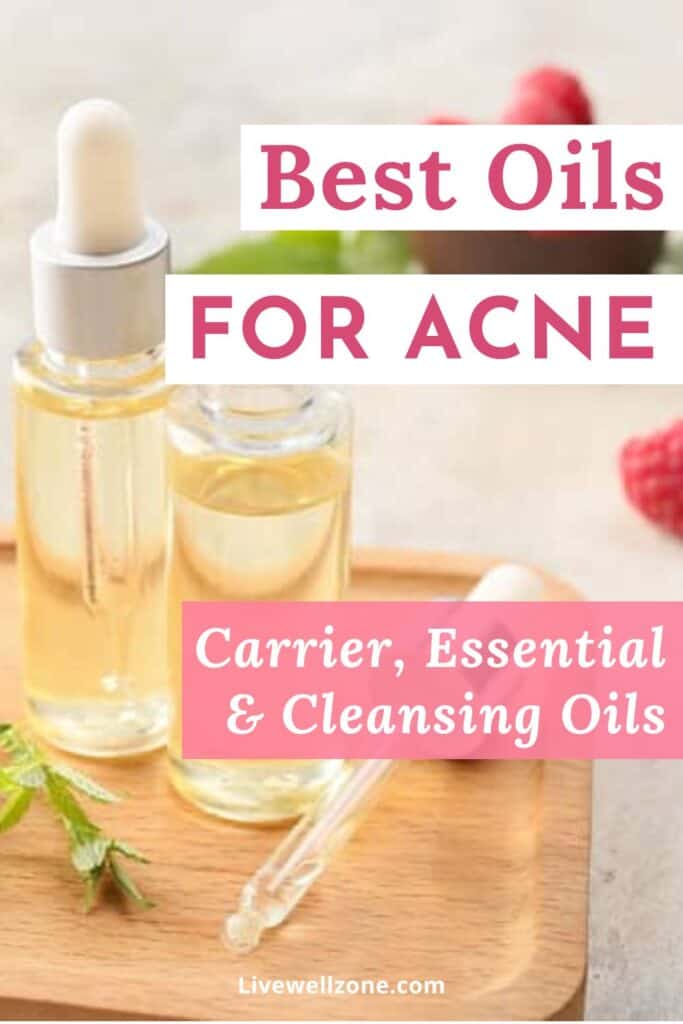
Adding oils to your skincare routine can be tremendously helpful for acne-prone skin. And with so many oils to choose from, knowing where to start can feel overwhelming. That’s why I’ve put together this guide on the best oils for acne prone skin.
By the end of this post you will be armed with everything you need to know about:
- choosing carrier oils for acne.
- essential oils that are scientifically-backed for the treatment of acne.
- how to add carrier and essential oils in your acne skincare routine.
Note: this post contains affiliate links and I earn a commission (at no additional cost to you) if you use them to make a purchase.
BEST CARRIER OILS FOR ACNE PRONE SKIN

The main reason why carrier oils are great for skin is that they:
- contain fatty acids, which are anti-inflammatory.
- support the skin barrier function.
- help to maintain a healthy microbiome on the skin.
While these general properties apply to all oils, the specific fatty acids in each oil varies. And these differences in fatty acids means some oils are lightweight, heavy, pore clogging, fast absorbing, slow to absorb and so on.
Now, while no one oil works exactly the same for everyone with acne, there are some general guidelines that can help you find an oil that is more likely to work for you. Here are some tips to follow (1, 2):
- Choose lightweight oils: lightweight oils tend to absorb faster and therefore, they’re less likely to sit on the skin (which can lead to clogged pores).
- Prioritize high linoleic acid content: some research shows that people with inflammatory skin conditions – including acne – produce sebum that is low in linoleic acid (and high in oleic acid). So, using oils that contain a higher ratio of linoleic acid (say 50% or more) may help with acne. Plus, oils rich in linoleic acid tend to be more lightweight too.
Please remember that the above are just general guidelines and not strict rules. You don’t have to completely shy away from oils that have less than 50% linoleic acid. It’s about finding the right balance for your skin.
Here are some carrier oils that can be helpful for acne.
| CARRIER OIL | PROPERTIES |
|---|---|
| Argan oil | – 48% oleic and 31-35% linoleic (source). – Lightweight with medium absorption rate. |
| Borage oil | – 36.6% linoleic, 18.5% oleic, 10.7% linolenic, 6.4% palmitic (source). – Slow absorption rate. |
| Evening primrose oil | – 70-74% linoleic acid and 8-10% linolenic acid (source) – Absorbs slowly. – Suitable for acne-prone skin that is dry or sensitive. |
| Fractionated coconut oil | Contains mainly medium chain fatty acids, which absorb easily and are less likely to clog pores. |
| Grapeseed oil | – 66–75.3% linoleic acid and 15% oleic acid (source). – Very lightweight and very fast absorption rate. |
| Jojoba oil | – 73.4% eicosenoic acid, 14.7% erucic acid, 8.3% oleic acid (source). – Resembles sebum (thanks to the presence of eicosenoic acid, which comprises about 25% of sebum). – Medium weight oil with fast absorption. |
| Meadowfoam oil | – 60% eicosenoic acid, which is a main component of sebum (source). – Regulates sebum. – Has a silky feel and fast absorption. |
| Prickly pear oil | – 61% linoleic acid and 25% oleic acid (source). – Fast absorption. |
| Pumpkin oil | – 51% linoleic acid and 26% oleic acid (source) – Medium absorption. |
| Red raspberry seed oil | – 54% linoleic and 32% linolenic (source) – Medium absorption |
| Rosehip oil | – 54.05% linoleic acid, 19.37% linolenic acid and 19.5% oleic acid (source). – Lightweight and fast absorption. |
| Safflower oil | – 76% linoleic acid and 13% oleic acid (source). – Fast absorption. |
| Sunflower oil | – 44-74% linoleic acid and 14-43% oleic acid (source). – Slow absorption. |
BEST ESSENTIAL OILS FOR PIMPLES

From popular oils like lavender and peppermint, to sweet florals like geranium and “precious” oils like frankincense or myrrh, there are lots of essential oils that are good for acne (yep, it’s not just tea tree!).
In fact, while going through this paper from the journal, Evidence-Based Complementary and Alternative Medicine, I came across dozen and dozens of oils that are helpful for acne.
So, based on the information from that paper, I’ve put together this list of essential oils for acne. As you go through the list, you’ll notice that some of the oils have additional benefits, such as regulating sebum, improving oily skin conditions and toning the skin.
| ESSENTIAL OIL | BENEFITS |
|---|---|
| Basil oil | acne |
| Cedarwood (Atlas) oil | acne, oily skin |
| Cedarwood (Virginia) oil | acne, clogged pores, oily skin |
| Bergamot oil | acne, oily skin |
| Cajaput oil | acne and oily skin |
| Caraway oil | acne and oily skin |
| Chamomile (Roman) | acne |
| Clary sage oil | acne, balances sebum, |
| Cypress oil | acne and clogged pores |
| Frankincense (carteri) | acne, oily skin, toner, scars |
| Geranium oil | acne, balances sebum, oily skin |
| Grapefruit oil | acne, oily skin, toner |
| Helichrysum oil | acne and scars |
| Lavandin oil | acne |
| Lavender (spike) oil | acne and oily skin |
| Lavender oil | acne, oily skin and scars |
| Lemon oil | acne, oily skin |
| Lime oil | acne, oily skin |
| Mandarin oil | acne, oily skin, scars |
| Manuka oil | acne |
| Myrrh oil | acne and scars |
| Myrtle oil | acne and oily skin |
| Niaouli oil | acne and oily skin |
| Neroli oil | acne, scars, toner |
| Orange (sweet) oil | acne, blocked pores, oily skin |
| Palmarosa | acne, balances sebum, scars, toner |
| Patchouli oil | acne and scars |
| Peppermint oil | acne, toner, greasy skin. |
| Petitgrain | acne, balances sebum, oily skin, toner |
| Rosemary oil | acne, balances sebum, oily skin, |
| Rosewood oil | acne, oily skin, scars |
| Sandalwood (Indian) oil | acne |
| Spanish sage oil | acne and oily skin |
| Spearmint oil | acne |
| Tangerine oil | acne, oily skin, toner |
| Tea tree oil | acne and oily skin |
| Vetiver oil | acne, balances sebum |
| Yarrow oil | acne, oily skin, scars |
Aside from the above oils, there are other oils that are said to be helpful for acne-prone skin, but they are also known to cause more skin irritations (compared to other oils).
I am including those oils below so that you are aware of what scientific journals have to say about acne and essential oils. However, these aren’t oils you’d want to attempt to use at home because you need very small, precise amounts. If you’re really dying to try these, consult with an aromatherapist first.
| ESSENTIAL OIL | BENEFITS |
|---|---|
| Bay laurel oil | acne and oily skin |
| Clove oil | acne |
| Garlic oil | acne |
| Lemongrass oil | acne, clogged pores, oily skin |
| May chang | acne and oily skin |
| Thyme oil | acne and oily skin |
| Ylang ylang | acne, balances sebum, oily skin, toner. |
BEST CLEANSING OILS FOR ACNE PRONE SKIN

For many people struggling with acne, switching from harsh cleansers to oil cleansing can help to reduce breakouts. This is because oil cleansing relies on oil (the “cleanser”) to bind to dirt. The end result is that you are able to remove surface dirt without totally stripping off your natural sebum, or potentially disrupting the balance of the skin microbiome.
Now, even though there are oil cleansing formulas on the market that you can buy, you can also start with just one carrier oil as your cleanser. Some of the best oils to use for oil cleansing on acne-prone skin include:
- argan oil
- avocado oil.
- castor oil *
- grapeseed oil.
- jojoba oil.
- olive oil.
- sunflower oil.
- sweet almond oil.
*NOTE: although castor is heavy you’ll find that the layer that remains on the skin after cleansing is quite thin. Furthermore, castor oil has anti-inflammatory and astringent properties that can be quite soothing for acne-prone skin.
HOW TO USE CARRIER AND ESSENTIAL OILS FOR PIMPLES
In this section we’re going to walk through how to oil cleanse, use facial oils and make your own acne spot treatment.
But before we do, please keep in mind that your success with oils depends heavily on their quality. If you’re serious about making these oils part of your skincare routine, then I recommend getting them from Mountain Rose Herbs.
They specialize in high quality, organic oils, essential oils, herbs, clays and all other goodies for skincare routine.
Get your carrier oils here from Mountain Rose Herbs.
Get your essential oils here from Mountain Rose Herbs.
1. As an oil cleanser
If you wear makeup, you can simply use the oil cleansing steps below to remove your makeup or you can use a face wipe first to get rid of your makeup. It really depends on just how much makeup you typically wear.
- Step 1: Pour a quarter-sized amount of carrier oil into the palm of your hand.
- Step 2: Rub your palms together to gently warm the oil and distribute it onto both palms.
- Step 3: Massage the oil onto dry skin for 1 minute. Use gentle pressure while doing this.
- Step 4: Take a soft washcloth (bamboo washcloth is especially good for this!) and run it under hot water. Wring out the water.
- Step 5: Press the washcloth onto your face for about 20 seconds. This starts the process of “melting off” dirt.
- Step 6: Using circular motions, gently rub the washcloth on your face to remove the oil.
- Step 7: If your skin still feels grimy, repeat steps 4 – 6.
NOTE: if you’re the DIY type and you want to make your own oil cleansing blend, here’s a fantastic tutorial from Whole Elise.
2. As a facial oil
- Use a single carrier oil or make a face oil with several carrier oils. This article on DIY facial oils contains a recipe for acne-prone skin that you can use. The article also walks you through proper dilution of essential oils for every day use.
- If you have naturally oily skin, you can often use the carrier oil as your moisturizer. Simply apply 2 to 5 drops of carrier oil to damp skin. Applying to damp skin actually seals in moisture (whereas applying the oil to dry skin just gives you a greasy look).
- For drier skin types, use the carrier oil in combination with a water-based moisturizer.
- When using a water-based moisturizer in your routine, apply the moisturizer first then follow up with the carrier oil.
3. Make an acne spot treatment
- You can easily make your own acne remedy by combining 45 drops of tea tree oil with 1 ounce of carrier oil. This makes a 5% dilution of tea tree, which has been shown to be effective against acne (source). For a complete guide on how to use tea tree (and other essential oils) check out this guide on how to dilute essential oils for skin.
CONCLUSION
When used correctly and consistently, oils can make a huge difference to the look and feel of acne-prone skin. Start with one or two oils – as opposed to several at once – so that you know which ones your skin responds to positively.
As you get more comfortable with these oils and you find your favorites, you can start to play around with blending and making your own acne remedies!

You Might Also Enjoy:
Grapeseed Oil vs Jojoba Oil for Skin: Which Is Better & How to Use
Essential and Carrier Oils Rich In Vitamin C: What You Should Know
What Kind Of Coconut Oil Is Best As A Carrier Oil for Skin? Fractionated vs Unrefined vs Refined
Evening Primrose Oil vs Rosehip Oil: Benefits, Differences, How to Use & Best Brands
Non-Greasy Carrier Oils For Skin: 10 Oils To Fall In Love With
Rosehip Oil vs Jojoba Oil for Face (And Body): Which is Better and How To Use
Best Carrier Oils for Sensitive Skin: 10 Oils To Soothe Dryness, Acne, Cracked Skin & More
What To Mix (And Not) With Rosehip Oil For Face – The Ultimate Guide
The Difference Between Rosehip Oil and Rosehip Seed Oil: Benefits, Which To Use and How to Use
How To Use Tea Tree Oil In Your Skin Care Routine (No More Blemishes!)
Carrier Oils By Skin Type: How to Choose and Simple List for Beginners

